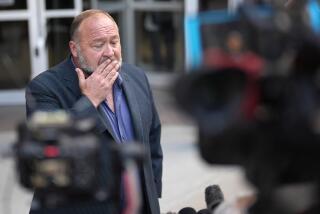Edwards Chain Accused of Lavish Payouts
- Share via
In the opening salvo of a contentious bankruptcy battle, Edwards Theatres Circuit Inc.’s main lender accused the movie chain of shelling out lavish salaries and other payments to Edwards’ family members while the company’s financial condition deteriorated.
Edwards issued a strong denial, calling lender Bank of America’s allegations “scurrilous.”
The bitter exchange unfolded as the giant bank and Southern California’s biggest movie house chain returned to Bankruptcy Court on Thursday, two weeks after Edwards filed for bankruptcy reorganization. In a normally routine proceeding, Edwards sought and was granted court permission to continue using its daily proceeds for ongoing operations, despite Bank of America’s objections and a host of assertions about Edwards’ internal financial management.
In its bankruptcy petition, Edwards largely blamed an industrywide overexpansion and a glut of older theaters for its financial downfall. But Bank of America’s filing claimed that while Edwards moved from a chain that earned $14 million in 1998 to one that lost $39.5 million last year, the closely held company provided more than $17 million in dividends, salaries and loans to family members.
But Edwards, in a response filed Thursday in bankruptcy court, said the bank’s statements were “woefully misleading” or presented out of context.
The bank used the bankruptcy proceeding as an “opportunity to cast a lot of aspersions and mistruths,” said Eric Goldberg, an attorney for Edwards.
Bankruptcy Judge Lynne Riddle, while noting that the bank was raising important issues, approved the movie chain’s request.
She said, however, that the bank’s assertions were “excessive,” and not relevant to Thursday’s hearings. She urged the two sides to take “the high road” and work together.
The ruling means Edwards can restock its concession stands with money earned from the sale of popcorn, candy and the like, for example.
Edwards needed court permission because a group of financial institutions, led by Bank of America, has a lien on a variety of assets, including even the snacks the exhibitor sells. Bank of America, concerned that Edwards’ inventory might drop as it closes more theaters, had asked the court to require Edwards to set aside $500,000 in a special account as collateral.
Edwards owes $217 million to a consortium of lenders headed by Bank of America.
According to the bank’s documents, five Edwards shareholders--all family members--received more than $14 million in dividends last year, up from $1.5 million in 1998, when the chain was profitable.
The shareholders include Bernice Edwards, the company’s co-chair and widow of founder James Edwards Sr., who died in 1997. Other shareholders are their three children, Chief Executive James Edwards III, Chief Corporate Officer Joan Edwards Randolph, and Treasurer Carole Ann Ruoff, as well as Patricia Edwards, wife of James Edwards III.
Edwards’ filing noted, however, that almost all of the dividends went toward federal and state taxes. Under the chain’s corporate structure, family shareholders, rather than the company, are responsible for paying business taxes. The filing did not disclose how much money was paid in taxes.
The bank also noted “munificent” annual salaries totaling $3.4 million that it says were paid to five family executives prior to April 1--including a $1.5 million salary for Chief Executive James Edwards III.
Edwards’ attorneys did not dispute the salary amounts stated in Bank of America’s documents, but noted that family members had voluntarily cut their pay in half in April, with Bank of America’s approval.
The bank also questioned the company’s spending right before the bankruptcy.
Its documents say that in the two days before filing for bankruptcy, the chain paid $14.3 million to a variety of recipients, including concessionaires, an insurance broker, a construction company and a landlord.
“Instead of conserving cash, the [company] practically gave it away,” the bank asserted.
Edwards said Bank of America simply is upset because the money was paid to businesses that provided critical services for the chain. Had the money been given to the bank instead, Edwards might have been forced to shut down, the company said.
The bank said its filing raises for the first time the “central issue” of the bankruptcy case, whether the chain will be allowed to continue operating for the “exclusive benefit of the Edwards family shareholders” or whether the court will require that Edwards protect the interests of the creditors.
Edwards characterized the bank’s assertions as simply an attempt to “sling some mud.”
The bank’s documents also described the company’s rapid descent into insolvency.
In August 1999, lenders agreed to provide Edwards with a $250-million credit line to refinance debt, fund theater expansion and provide working capital, the bank said.
But by the end of that year, Edwards was “massively in default,” and its cash flow from operations fell to $571,000, compared to more than $84.3 million in 1998, according to the bank’s filing.
By early 2000, the document says, the company was running out of cash, and Edwards asked to borrow more money. The chain also said it had put the company up for sale, the filing added. Another $15-million loan was issued in May to “provide a bridge to the sale or other restructuring” of the company, the bank said.
Edwards was to have paid back the entire amount by Aug. 31, but still owed $8.5 million when it filed for bankruptcy.
Edwards executives acknowledged recently that they considered selling the business, but decided it would not be “in the best interests of the family or the company.”
More to Read
The biggest entertainment stories
Get our big stories about Hollywood, film, television, music, arts, culture and more right in your inbox as soon as they publish.
You may occasionally receive promotional content from the Los Angeles Times.










